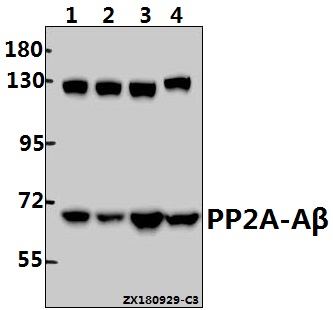Product Name :
PPP2R1B polyclonal antibody Background :
In eukaryotes, the phosphorylation and dephosphorylation of proteins on serine and threonine residues is an essential means of regulating a broad range of cellular functions, including division, homeostasis and apoptosis. A group of proteins that are intimately involved in this process are the protein phosphatases. In general, the protein phosphatase (PP) holoenzyme is a trimeric complex composed of a regulatory subunit, a variable subunit and a catalytic subunit. Four major families of protein phosphatase catalytic subunits have been identified, designated PP1, PP2A, PP2B (calcineurin) and PP2C. An additional protein phosphatase catalytic subunit, PPX (also known as PP4), is a putative member of a novel PP family. The PP2A family comprises subfamily members PP2Aα and PP2Aβ. The PP2A catalytic subunit associates with a variety of regulatory subunits. Regulatory subunits include PP2A-Aα and -Aβ, PP2A-Bα and -Bβ, PP2A-Cα and -Cβ, and PP2A-B56α and -B56β. Product :
Rabbit IgG, 1mg/ml in PBS with 0.02% sodium azide, 50% glycerol, pH7.2 Storage&Stability :
Store at 4°C short term. Aliquot and store at -20°C long term. Avoid freeze-thaw cycles. Specificity :
PPP2R1B polyclonal antibody detects endogenous levels of PPP2R1B protein. Immunogen :
Synthetic peptide, corresponding to amino acids 556-601 of Human PPP2R1B. Conjugate :
Unconjugated Modification :
Unmodification
PPP2R1B polyclonal antibody Background :
In eukaryotes, the phosphorylation and dephosphorylation of proteins on serine and threonine residues is an essential means of regulating a broad range of cellular functions, including division, homeostasis and apoptosis. A group of proteins that are intimately involved in this process are the protein phosphatases. In general, the protein phosphatase (PP) holoenzyme is a trimeric complex composed of a regulatory subunit, a variable subunit and a catalytic subunit. Four major families of protein phosphatase catalytic subunits have been identified, designated PP1, PP2A, PP2B (calcineurin) and PP2C. An additional protein phosphatase catalytic subunit, PPX (also known as PP4), is a putative member of a novel PP family. The PP2A family comprises subfamily members PP2Aα and PP2Aβ. The PP2A catalytic subunit associates with a variety of regulatory subunits. Regulatory subunits include PP2A-Aα and -Aβ, PP2A-Bα and -Bβ, PP2A-Cα and -Cβ, and PP2A-B56α and -B56β. Product :
Rabbit IgG, 1mg/ml in PBS with 0.02% sodium azide, 50% glycerol, pH7.2 Storage&Stability :
Store at 4°C short term. Aliquot and store at -20°C long term. Avoid freeze-thaw cycles. Specificity :
PPP2R1B polyclonal antibody detects endogenous levels of PPP2R1B protein. Immunogen :
Synthetic peptide, corresponding to amino acids 556-601 of Human PPP2R1B. Conjugate :
Unconjugated Modification :
Unmodification
-
 Western blot (WB) analysis of PP2A-Aβ (F590) pAb at 1:1000 dilution Lane1:A2780 whole cell lysate(40ug) Lane2:Beas-2B whole cell lysate(40ug) Lane3:Myla2059 whole cell lysate(40ug) Lane4:3T3-L1 whole cell lysate(40ug)
Western blot (WB) analysis of PP2A-Aβ (F590) pAb at 1:1000 dilution Lane1:A2780 whole cell lysate(40ug) Lane2:Beas-2B whole cell lysate(40ug) Lane3:Myla2059 whole cell lysate(40ug) Lane4:3T3-L1 whole cell lysate(40ug)
Bioworld Biotech only provide peptides for our antibodies and do not provide additional peptide customization services.
Price/Size :
USD 368/1mg/vial
Tips:
For phospho antibody, we provide phospho peptide(0.5mg) and non-phospho peptide(0.5mg).Describe :
Blocking peptides are peptides that bind specifically to the target antibody and block antibody binding. These peptide usually contains the epitope recognized by the antibody. Antibodies bound to the blocking peptide no longer bind to the epitope on the target protein. This mechanism is useful when non-specific binding is an issue, for example, in Western blotting (WB) and Immunohistochemistry (IHC). By comparing the staining from the blocked antibody versus the antibody alone, one can see which staining is specific; Specific binding will be absent from the western blot or IHC performed with the neutralized antibody.Formula:
Synthetic peptide was lyophilized with 100% acetonitrile and is supplied as a powder. Reconstitute with 0.1 ml DI water for a final concentration of 10 mg/ml.The purity is >90%,tested by HPLC and MS.
Storage:
The freeze-dried powder is more stable. For short time at 2-8°C. For long term storage store at -20°C.
Note :
This product is for research use only (RUO only). Not for use in diagnostic or therapeutic procedures.
 PPP2R1B polyclonal antibody
PPP2R1B polyclonal antibody  Datasheet
Datasheet COA
COA MSDS
MSDS SHIP
SHIP